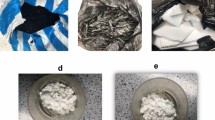Abstract
Polymers, such as plastics, are composed of polymeric compounds that may be formed into solid objects of different shapes formed by applying pressure and heat. Plastics are utilized in a range of sectors, including the medical area, automotive, electrical, and packaging. Most modern plastics are made of substances derived from fossil fuels, like natural gas or petroleum. Plastics used in containers and packaging include polyethylene (PE), polypropylene (PP), polystyrene (PS), and polycarbonate (PC). Plastic wastes are thermally pyrolyzed to yield a wide range of hydrocarbons, from waxy compounds to methane. High temperatures are involved in this procedure. Although it is possible to burn the gaseous compounds produced to provide the process heat requirements, the pyrolysis process is rarely used as a feedstock recycling method for the plastic waste stream because of the low overall output of useful gasoline range hydrocarbons. This study presents FT-IR and GC–MS investigations of a zeolite-catalyzed pyrolysis method for fuel extraction through plastic recycling.




Similar content being viewed by others
References
R. Geyer, J.R. Jambeck, K.L. Law, Production, use, and fate of all plastics ever made—supplementary information. Sci. Adv. 3(7), 19–24 (2017). https://doi.org/10.1126/sciadv.1700782
Press Trust of India, India produces 25,000 tonnes plastic waste daily, 40% uncollected: centre. NDTV.com, November 22, vol. 45 (2019)
M.K. Biddinika, M. Syamsiro, A.N. Hadiyanto, Z. Mufrodi, F. Takahashi, Technology for public outreach of fuel oil production from municipal plastic wastes. Energy Procedia 142, 2797–2801 (2017). https://doi.org/10.1016/j.egypro.2017.12.424
A. Garfroth, S. Ali, J.H. Martínez, A. Akah, Feed stock recycling of polymer wastes. Curr. Opin. Solid State Mater. Sci. 6, 419–425 (2004)
G. Scott, Antioxidant control of polymer biodegradation, in Degradability, Renewability and Recycling. 5th International Science Workshop on Biodegradable Plastics and Polymers, Macromolecular Symposia (1998)
W. Sriningsih, M.G. Saerodji, W. Trisunaryanti, A. Triyono, R. Armunanto, I.I. Falah, Fuel production from LDPE plastic waste over natural zeolite supported Ni, Ni-Mo, Co and Co-Mo metals. Procedia Environ. Sci. 20, 215–224 (2014). https://doi.org/10.1016/j.proenv.2014.03.028
M.F. Ali, S. Ahmed, M.S. Qureshi, Catalytic coprocessing of coal and petroleum residues with waste plastics to produce transportation fuels. Fuel Process. Technol. 92, 1109–1120 (2011). https://doi.org/10.1016/j.fuproc.2011.01.006
N. Miskolczi, L. Bartha, A. Angyal, High energy containing fractions from plastic wastes by their chemical recycling. Macromol. Symp. 245–246, 599–606 (2006). https://doi.org/10.1002/masy.200651386
M. Fionnuala, M. Kevin, G. Devlin, The evaluation of viscosity and density of blends of Cyn-diesel pyrolysis fuel with conventional diesel fuel in relation to compliance with fuel specifications. Fuel 91, 112–118 (2012). https://doi.org/10.1016/j.fuel.2011.06.032
S. Pooja, V. Bharath, P.N. Rao, Ionic liquid-encapsulated zeolite catalysts for the conversion of glucose to 5-hydroxymethylfurfural. Chem. Sel. 2, 10379–10386 (2017). https://doi.org/10.1002/slct.201701955
K. Sachin, Preparation and characterization of acids and alkali treated kaolin clay. Bull. Chem. React. Eng. 8, 61–69 (2013)
G. Scott, Abiotic control of polymer biodegradation. Trends Polym. Sci. 11, 361–368 (1997)
M. Sarker, M.M. Rashid, Waste plastics mixture of polystyrene and polypropylene into light grade fuel using Fe2O3 catalyst. Int. J. Renew. Energy Technol. Res. (IJRETR) 2(1), 17–28 (2013)
M. Syamsiro, H. Saptoadi, T. Norsujianto, P. Noviasri, S. Cheng, Z. Alimuddin, K. Yoshikawa, Fuel oil production from municipal plastic wastes in sequential pyrolysis and catalytic reforming reactors. Energy Procedia 47, 180–188 (2014)
A. Lopez, I. Marco d, B.M. Caballero, M.F. Laresgoiti, A. Adrados, A. Torres, Pyrolysis of municipal plastic waste II: influence of raw material composition under catalytic conditions. Waste Manag. 31, 1973–1983 (2011)
K. Murthy, R.J. Shetty, K. Shiva, Plastic waste conversion to fuel: a review on pyrolysis process and influence of operating parameters. Energy Sources A Recov. Util. Environ. Eff. 45(4), 11904–11924 (2020). https://doi.org/10.1080/15567036.2020.1818892
S.L. Kumar, S. Radjarejesri, R. Jawahar, Characterization of waste plastic oil as biodiesel in IC engines. Mater. Today Proc. (2020). https://doi.org/10.1016/j.matpr.2020.06.272
P. Palmay, C. Haro, I. Huacho, D. Barzallo, J.C. Bruno, Production and analysis of the physicochemical properties of the pyrolytic oil obtained from pyrolysis of different thermoplastics and plastic mixtures. Molecules 27(10), 3287 (2022). https://doi.org/10.3390/molecules27103287
F. Mabood, J. Shah, M.R. Jan, Z. Hussain, F. Jabeen, Catalytic conversion of waste low density polyethylene into valuable products. J. Chem. Soc. Pak. 32(5), 767–773 (2010)
Funding
The authors declare that no funds, grants, or other support was received during the preparation of this manuscript.
Author information
Authors and Affiliations
Contributions
NDSGB involved in conceptualization, methodology, formal analysis, investigation, validation, and writing—original draft. VP took part in visualization, data analysis, and data curation. SPS involved in supervision, writing—review and project administration. ST involved in final draft writing and editing.
Corresponding author
Ethics declarations
Competing interests
Authors have no relevant financial or non-financial interest to disclose. The authors declare that this work was not carried out by anyone so far.
Additional information
Publisher's Note
Springer Nature remains neutral with regard to jurisdictional claims in published maps and institutional affiliations.
Rights and permissions
Springer Nature or its licensor (e.g. a society or other partner) holds exclusive rights to this article under a publishing agreement with the author(s) or other rightsholder(s); author self-archiving of the accepted manuscript version of this article is solely governed by the terms of such publishing agreement and applicable law.
About this article
Cite this article
Babu, N.D.S.G., Ponnam, V., Tondepu, S. et al. Enhanced Catalytic Pyrolysis for Sustainable Transformation of Waste Plastics into Energy Resources. J. Inst. Eng. India Ser. D (2024). https://doi.org/10.1007/s40033-024-00672-1
Received:
Accepted:
Published:
DOI: https://doi.org/10.1007/s40033-024-00672-1




